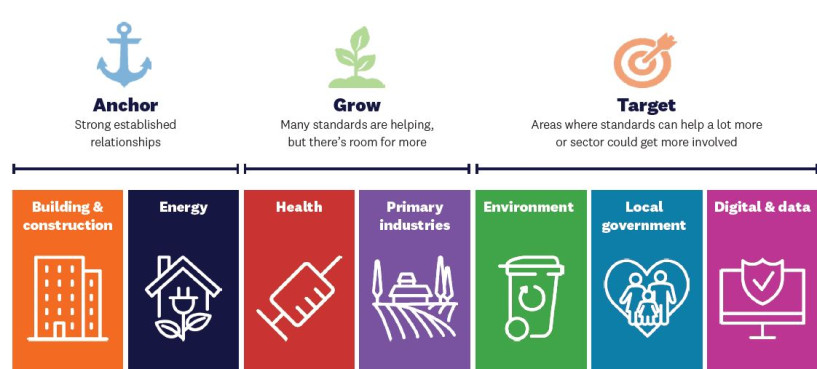Achievements and opportunities
On this page
Growing value for New Zealand
In order to deliver on its strategy and vision to grow value for New Zealand, Standards New Zealand continues to expand its networks within these priority sectors:
Collaboration with these sectors has been prioritised so as to help Standards New Zealand achieve mutually agreed outcomes across one or more of its key levers: standards development; refreshing the aged catalogue of standards; participation in the development of international standards; pre-funded access to standards and Standards New Zealand's value-add programme.
Achievements
In the past year, Standards New Zealand has continued to engage with selected priority sectors, including the building and construction, energy, health, and digital economy sectors.
- Standards New Zealand has successfully entered, or was finalising at the time of this report, medium-term strategic contracts with WorkSafe – Energy Safety and the Energy Efficiency and Conservation Authority (EECA) and is managing the revision of some key standards for the building regulator within the Ministry of Business, Innovation and Employment (MBIE).
- Standards New Zealand continues to engage with government agencies on key reforms and priorities, including health reforms, climate change and environmental reform issues, water quality, the digital economy, and housing.
- Relationships with several priority sectors are strengthening. There's a growing awareness of Standards New Zealand's brand and its work thanks to our engagement with them on ‘communities of practice and consultative working groups regarding proposed legislative reforms (particularly in the digital and environment sectors). As a result, industry bodies and regulators, including the New Zealand Infrastructure Commission/Te Waihanga, the External Reporting Board Te Kāwai Ārahi Pūrongo Mōwaho (XRB), Te Whatu Ora Health New Zealand, Agritech Industry Transformation Plan (ITP) agencies, Te Kōtui Whitiwhiti – Digital Public Service, Stats NZ Tatauranga Aotearoa, and Waka Kotahi NZ Transport Agency, approached us with enquiries, some of which included initiative exploration.
- During 2021/22, Standards New Zealand facilitated the following for its priority sectors and areas: (2)
- the development and publication of standards and guidelines used widely in the building and construction sector
- the review of six international standards relating to the energy efficiency and energy safety sectors
- the development of standards and guidelines in collaboration with EECA and the energy efficiency sector
- the development of guidelines in the energy demand flexibility and decarbonisation areas
- the initiation of a revision of NZS 8100 Dairy herd testing standard in collaboration with DairyNZ
- the completion of two new standards, NZS 8409 Management of agrichemicals and AS/NZS 4798 Sustainable forest management, in the primary industries sector.
- Standards New Zealand also continues to strengthen its relationships with its priority sectors. Key examples include(3):
- Health: There is ongoing discussion with the Ministry of Health/Manatū Hauora concerning the establishment of Te Whatu Ora Health New Zealand and Te Aka Whai Ora/Māori Health Authority. Standards New Zealand sees significant opportunity to advance its standards work in this sector to support these structural reform successes, with the coming together of multiple agencies and more than 80,000 employees into one national health system requiring standardisation of process, systems, and health practices.
- Primary industries: Standards New Zealand continues to engage with industry bodies and the Ministry for Primary Industries/Manatū Ahu Matua. Supporting the sector’s goal of reducing barriers to trade is the main opportunity. Standards New Zealand continues to encourage the sector to participate in ISO committees and ensure that their standards are up to date and fit for purpose.
- Local government: Members of this disparate group tend to use rather than develop standards (this use is directed by way of legislation and the mandates they are responsible for). Local governments understand the importance of standards to the systems, process, and compliance mechanisms that they govern. As such, there is opportunity for Standards New Zealand to explore developing publicly accessible specifications (PAS, or voluntary guidelines) for local government on how to use the standards that apply to them.
- Environment: Standards New Zealand engages with several government agencies working on environmental policy based on New Zealand’s obligations under, inter alia, the Paris Agreement and treaties with international bodies such as the World Trade Organization (WTO), the World Health Organization (WHO) and the United Nations (UN). In particular, Standards New Zealand has helped the Ministry for the Environment/Manatū Mō Te Taiao(external link), XRB, and the New Zealand Infrastructure Commission/Te Waihanga access relevant ISO standards and promoted the opportunity for them to be more directly involved in international committees.
- Digital and data: This year, Standards New Zealand’s Sector Engagement Lead began chairing the Digital and Data Standards Community of Practice. This has enabled Standards New Zealand to share the standards value story, giving the group a better understanding of Standards New Zealand’s role within the conformity system and how this system can support joint work. The community has a wide reach across the digital and data sector, particularly in the public sector.
- Data interoperability: This trend between government agencies represents an opportunity for Standards New Zealand to work across government and embed standards in legislation.
Reviewing standards for hydrogen integration
With hydrogen set to change the way the world manufactures and uses energy, it’s important to ensure safety in this emerging field.
WorkSafe – Energy Safety therefore commissioned Standards New Zealand to explore the standards framework for integrating hydrogen to support a low-carbon economy and as an alternative to fossil fuels and industrial feedstock. Standards New Zealand identified 10 key areas which were then checked against regulation: safety, inspection, validation, metering, fuel station equipment, fuel station design, network distribution, production, purification, and mobility.
Following a sector-wide scoping workshop, a plan for an in-depth standards review was presented to the regulator. By adapting international standards that take New Zealand's unique infrastructural, regulatory, and geographical needs into account, government and industry can avoid reinventing the wheel. Nevertheless, as hydrogen is progressively integrated into New Zealand’s energy landscape, Standards New Zealand will be seeking further advice on whether these standards remain fit for purpose.

Digitisation of standards
Standards New Zealand's goal is to produce and publish digital editions in multiple formats for all standards content and to provide seamless access from its website. Digitisation will:
- better meet users’ changing needs (for example, being able to use a mobile device, web browser, or apps and software packages such as CAD or building information modelling [BIM] to easily use a standard).
- represent a potentially important new income stream for Standards New Zealand.
- align Standards New Zealand with other comparable standards bodies, including Standards Australia, which have already digitised their standards catalogue to meet market expectations and needs.
Beyond the benefits to its customers of digitising these documents (such as improving ease of access and utility), achieving this goal will also help Standards New Zealand maintain credibility as a professional publisher and standards body by keeping apace of modern practices and market expectations.
Achievements
- During 2021, Standards New Zealand produced five digitised standards in alternative formats as a pilot. One thousand people accessed these digital editions, and when surveyed, more than 80% of those that responded were keen to see all standards in a browser-based format. The plan is to deliver digital editions on a larger scale in the future.
- Standards New Zealand issued its first commercial digital products licence. The recipient business, which sells a self-assessment compliance tool for information security systems, licensed three ISO/IEC standards.
- A trial of the first component of digital publishing transformation commenced. The tool, eXtyles, turns standards to XML format for future digitised publication.
- A business case is being developed to determine what is involved and how much funding would be required to digitise a large part of our standards catalogue.
- Standards New Zealand will progress its digitisation programme and other information and communication technology (ICT) ambitions as funding enables. These ambitions include:
- formats tailored for mobile devices, web browsers and apps. Many standards users would like standards to be available in mobile-accessible formats. This would help improve ease of access and use and perhaps also result in better compliance
- website enhancements. Along with improving web functionality such as the search engine and standards development consultation features, the enhancements could provide ready access and sale of digital editions.
Education and information
Achievements
- Standards New Zealand has improved its website over the past 12 months by creating a more engaging browser experience. Content is regularly updated, and information is designed to enhance the customer’s understanding of Standards New Zealand’s work and value.
- In addition to the regular Touchstone newsletter, Standards New Zealand has introduced a suite of sector-specific newsletters, which have been well received by stakeholders.
- Marketing and communications activities have helped to educate and guide users in using, adopting and commissioning standards and participating in their development.
- Standards New Zealand and the Department of the Prime Minister and Cabinet (DPMC) are discussing standards for the Internet of Things. Standards New Zealand is advising and providing feedback through the interagency working group.
International participation
Standards New Zealand participates in and supports the global standards and conformance system. It is also a country member of both the International Organization for Standardization (ISO) and the International Electrotechnical Commission (IEC).
Achievements
- Standards New Zealand facilitated participation in and observation of 212 ISO and 124 IEC committees in the past year (see Table 1). This work is important because it enables New Zealand to understand and influence the development of international standards that will have an impact on New Zealand’s interests (for example, international trade).
- We are obligated to respond to all ballots released by ISO and IEC where we are participating (P) members of these international standards committees. For the year to 30 June 2022, our voting record was 100% submitted by the due date.
- In the past 12 months, the Standards Approval Board approved 39 new ISO and IEC committee members. To facilitate the development of expertise, Standards New Zealand actively reviews the composition of New Zealand’s ISO and IEC committees, especially those that sit within identified priority sectors.
- Other international activities in 2021/22 included:
- forming one new technical committee (participation membership)
- establishing New Zealand membership of ISO’s strategic advisory group (SAG) on smart farming
- facilitating two IEC National Committee of New Zealand (NCNZ) meetings
- being actively involved and representing New Zealand at:
The IEC NCNZ meetings took place in-person, whereas the others were held online.
Table 1 – New Zealand involvement in ISO and IEC committees July 2021 to June 2022
|
Committee type |
Total ISO and IEC committees |
New Zealand membership of |
||
|
Participant role |
Observer role |
|||
|
ISO |
Technical committees |
264 |
27 |
72 |
|
Subcommittees |
523 |
43 |
67 |
|
|
Policy development committees |
3 |
1 |
2 |
|
|
Total |
790 |
212 |
||
|
IEC |
Technical and Systems committees |
110 |
7 |
60 |
|
Subcommittees |
103 |
7 |
50 |
|
|
Total |
213 |
124 |
||
New participation memberships established since June 2021
ISO TC 274 Light and lighting
New observer memberships established since June 2021
ISO TC 34 SC 20 Food loss and waste
ISO/TC 44 SC 05 Testing and inspection of welds
IEC TC 129 Robotics for electricity generation, transmission, and distribution systems
ISO/TC 135 SC 02 Surface methods
ISO/TC 135 SC 03 Ultrasonic testing
ISO/TC 135 SC 04 Eddy current testing
ISO/TC 135 SC 05 Radiographic testing
ISO TC 336 Laboratory design
ISO PC 337 Guidelines for the promotion and implementation of gender equality
ISO TC 339 Small hydropower plants

